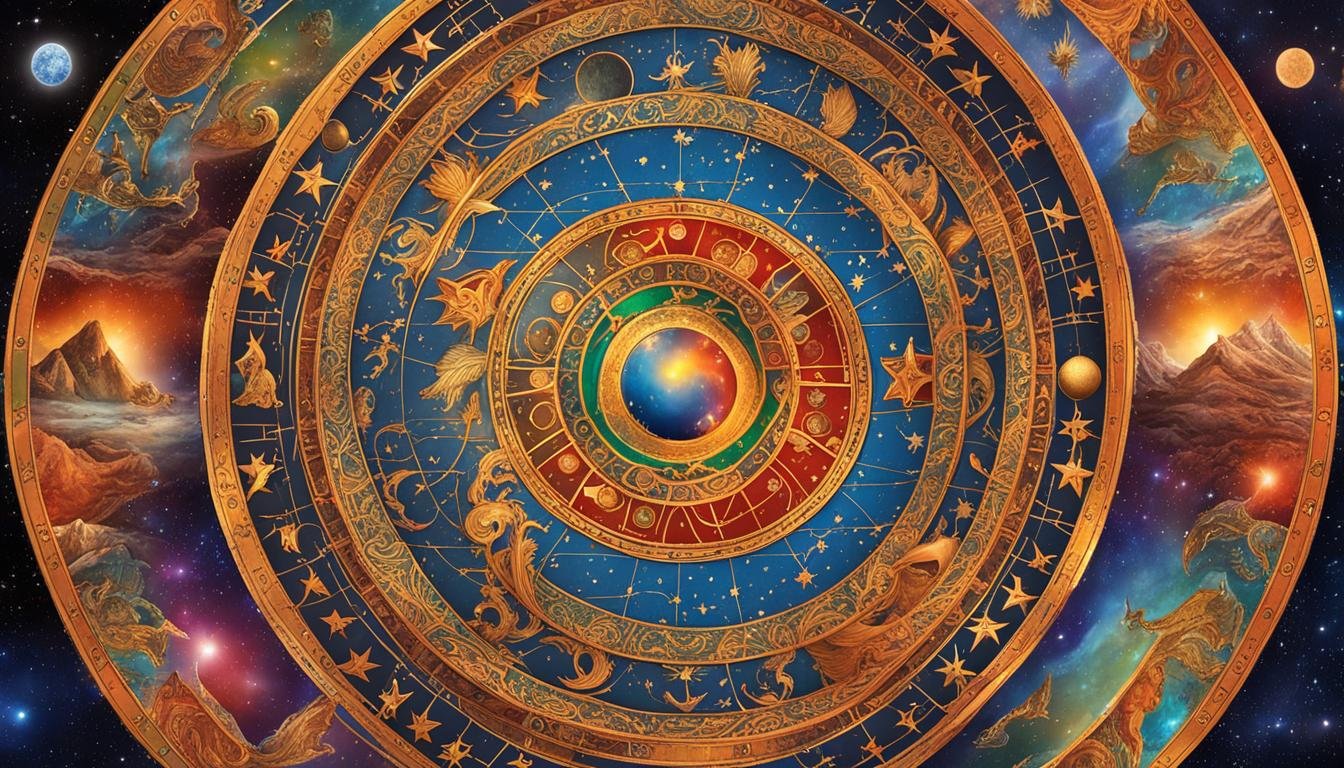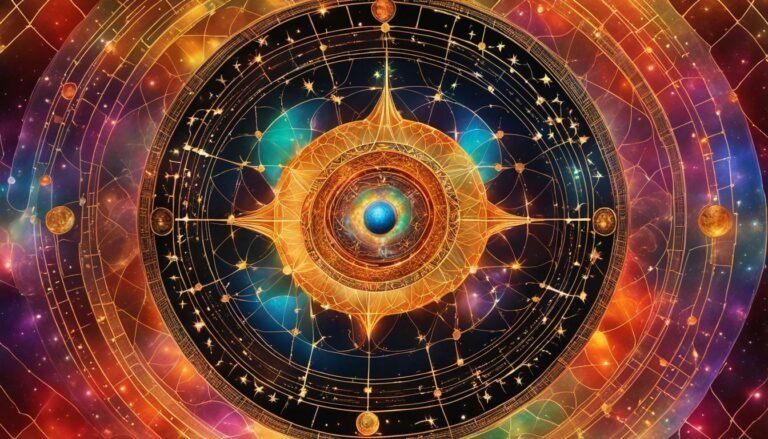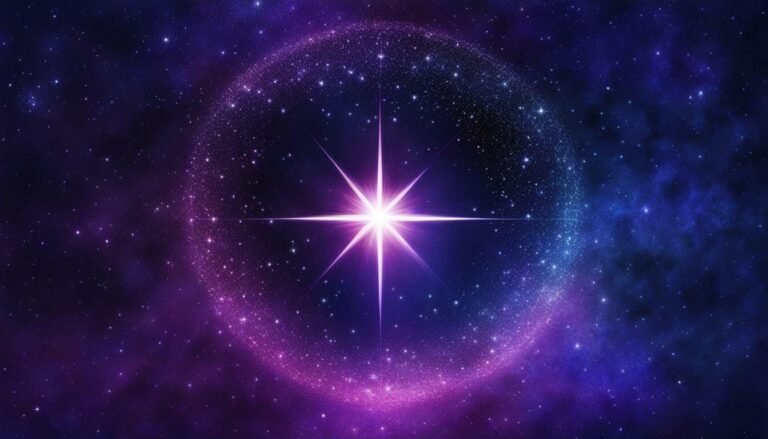27 Nakshatras in Vedic Astrology: A Comprehensive Guide
In Vedic astrology, the 27 Nakshatras, also known as lunar mansions, hold significant importance.
These celestial divisions, approximately 13°20’ in length, play a crucial role in predicting an individual’s life and understanding their cosmic journey.
The Nakshatras have a rich mythological background and are mentioned in ancient texts like the Rig Veda, Yajurveda, and Atharva Veda.
By exploring the intricacies of these Nakshatras, you can gain a deeper understanding of Vedic astrology and its influence on your life.
Key Takeaways:
- The 27 Nakshatras are lunar mansions that determine an individual’s life and characteristics in Vedic astrology.
- Accurate birth details are required to determine one’s Nakshatra.
- Nakshatras are divided into four quarters called Padas, each representing a zodiac sign.
- Each Nakshatra has unique characteristics, ruling deities, and planetary energies.
- Understanding your Nakshatra can provide insights into your traits, compatibility, and karmic influences.
The 27 Nakshatras of Vedic Astrology
Abhijit Nakshatra is a unique and often discussed concept in Vedic astrology. Unlike the regular 27 Nakshatras, or lunar mansions, Abhijit is sometimes considered as the 28th Nakshatra. However, its status and usage can vary depending on the astrological tradition and the astrologer’s approach.
How to Determine Your Nakshatra
To determine your Nakshatra, you need to provide an astrologer with your accurate birth details, including the date, place, and exact time of birth. The position of the Moon at the time of your birth determines your Nakshatra.
Your horoscope also plays a vital role in providing additional details about your Sun and Moon positions. By analyzing these factors, an astrologer can accurately determine your Nakshatra and provide insights into your well-being and characteristics.
To determine your Nakshatra, follow these steps:
- Collect your accurate birth details, including the date, place, and exact time of birth.
- Consult an astrologer who specializes in Vedic astrology.
- Provide the astrologer with your birth details.
- The astrologer will analyze your birth chart and determine the position of the Moon at the time of your birth.
- Based on the Moon’s position, the astrologer will identify your Nakshatra.
- Once your Nakshatra is determined, the astrologer can provide insights into your personality, strengths, weaknesses, and life path.
Remember, accurate birth details are crucial for an astrologer to determine your Nakshatra. Providing incorrect or approximate information may lead to inaccurate results. Therefore, always ensure that you have the correct birth details before consulting an astrologer for Nakshatra determination.
The 27 Nakshatras: Categories and Meanings
The 27 Nakshatras in Vedic astrology can be categorized based on various attributes, giving each Nakshatra its own unique characteristics and significance. By understanding these categories, you can gain deeper insights into the Nakshatras and their meanings. Here are some key categories:
Ruling Planet
- Each Nakshatra is associated with a ruling planet, which influences its energy and qualities.
- The ruling planets include the Sun, Moon, Mars, Mercury, Jupiter, Venus, Saturn, Rahu, and Ketu.
Deity
- Every Nakshatra is connected with a specific deity, representing the divine energy and symbolism associated with that Nakshatra.
- Deities range from gods and goddesses to celestial beings and mythical figures.
Sex and Temperament
- The Nakshatras are classified into male and female categories, each with its own unique attributes and characteristics.
- Male Nakshatras are often associated with activity, enthusiasm, and assertiveness, while female Nakshatras are linked to nurturing, intuition, and receptivity.
Animal Symbolism
- Each Nakshatra is represented by a specific animal, which symbolizes certain qualities and traits.
- The animal symbolism adds depth to the understanding of the Nakshatras and provides insights into their energies and influences.
These categories help astrologers and enthusiasts delve deeper into the meanings and characteristics of the 27 Nakshatras. By exploring the ruling planets, deities, sex and temperament, as well as animal symbolism, a comprehensive understanding of the Nakshatras can be gained. This knowledge is invaluable in predicting and interpreting various aspects of life, including compatibility in relationships, career choices, and spiritual growth.

Pada in Nakshatras: The Integration of Zodiac Signs
Each Nakshatra is divided into four parts called Padas, and each Pada represents a zodiac sign. The Padas serve as an integration of the zodiac signs, providing additional layers of meaning and interpretation. The traits and characteristics associated with each zodiac sign are infused into the Padas, creating a unique blend of energies and influences.
The integration of zodiac signs in the Padas starts with Aries as the first zodiac sign, followed by Taurus, Gemini, and so on. With each Nakshatra spanning approximately 2.25 parts of a zodiac sign, there are a total of 9 Padas within the 27 Nakshatras. These Padas play a significant role in shaping an individual’s spiritual essence and personality traits.
Zodiac Sign Integration in Padas
- The first Pada of each Nakshatra is influenced by the zodiac sign it falls in. This integration adds a distinct flavor and quality to the Nakshatra’s energy.
- The second Pada inherits the traits of the subsequent zodiac sign, creating a harmonious blending of energies.
- The third Pada embodies the essence of the following zodiac sign, infusing its unique attributes into the Nakshatra’s influence.
- The fourth and final Pada draws its qualities from the zodiac sign that comes after, contributing its distinctive characteristics to the Nakshatra’s overall energy.
The Pada system provides astrologers with deeper insights into a person’s character and nature. By understanding the integration of zodiac signs within each Nakshatra, astrologers can unravel the multidimensional aspects of an individual’s personality, guiding them towards a deeper self-awareness and spiritual growth.
Discovering Your Pada
To determine your Pada within a specific Nakshatra, astrologers analyze your birth chart and the position of the Moon at the time of your birth. By identifying the Nakshatra and its corresponding Pada, astrologers can provide you with valuable insights into your strengths, weaknesses, and cosmic purpose.
It’s important to note that while the Padas integrate the qualities of different zodiac signs, they do not override the overall influence of the Nakshatra itself. The Padas serve as a complementary layer, enhancing and refining the core attributes of each Nakshatra.
Understanding the Pada system and its integration with zodiac signs allows for a more holistic and comprehensive interpretation of an individual’s astrological chart. By delving into the intricate connections between Nakshatras and zodiac signs, astrologers can provide accurate guidance and deep insights into various aspects of a person’s life journey.
Characteristics of Nakshatra: Symbolism and Significance
In Vedic astrology, the 27 Nakshatras, also known as lunar constellations, hold deep symbolism and significance. Each Nakshatra corresponds to ruling deities, planetary energies, and various attributes, providing valuable insights into an individual’s life and traits. Understanding the characteristics of Nakshatras is essential for astrologers to interpret their effects accurately and provide guidance.
Symbolism of Nakshatras
The Nakshatras are rich in symbolism, representing various aspects of human life. They correspond to attributes such as caste, sex, dosha, temperament, and animal symbolism. Each Nakshatra embodies a certain energy or guna, which manifests through three different levels: Rajas, Tamas, and Sattva. This symbolism is carefully considered when interpreting the effects of Nakshatras on an individual’s personality and life events.
Significance of Nakshatras
Understanding the significance of Nakshatras helps astrologers provide accurate predictions and guidance. Nakshatras play a vital role in determining an individual’s ambitions, energy levels, and compatibility with others. They provide insights into an individual’s karmic influences and help guide important decisions, such as finding auspicious timings for significant events or understanding compatibility in marriage.
- The Nakshatras hold immense importance in Vedic astrology.
- They represent different energies and gunas of individuals.
- Understanding Nakshatras helps in interpreting personality traits and life events.
- Astrologers use Nakshatras to provide accurate predictions and guidance.
The symbolism and significance of Nakshatras make them an invaluable tool in understanding oneself and navigating life’s journey. By delving into the characteristics of Nakshatras, astrologers can unlock profound insights into an individual’s unique cosmic makeup and help guide them towards a more fulfilling and purposeful life.
Nakshatras vs Zodiac Signs: Understanding the Difference
When it comes to understanding the celestial divisions that influence our lives, Nakshatras and zodiac signs play significant roles. While both are used in astrology, they have distinct differences that shape the way we interpret cosmic influences. Let’s explore the disparities between Nakshatras and zodiac signs to gain a deeper understanding of their unique characteristics.
Key Differences:
- Nakshatras: Nakshatras divide the sky into 27 equal parts, each approximately 13.33° long. They are based on the position of the Moon at the time of a person’s birth, providing insights into their emotions, intuition, and subconscious influences.
- Zodiac Signs: Zodiac signs divide the sky into twelve equal parts, each covering a zone of 30°. They are based on the position of the Sun at the time of a person’s birth, representing their core personality traits, ego, and conscious self.
Another significant difference lies in their integration. Each Nakshatra is further divided into four parts called Padas, which align with specific zodiac signs. This integration allows astrologers to gain a comprehensive understanding of an individual’s character, combining the influences of both the Nakshatra and the corresponding zodiac sign.
While zodiac signs focus on a person’s conscious self and personality, Nakshatras delve deeper into their emotional and intuitive nature. They provide valuable insights into an individual’s inner world, subconscious motivations, and karmic influences. By considering both Nakshatras and zodiac signs, astrologers can provide a holistic interpretation of a person’s cosmic journey.
Understanding the difference between Nakshatras and zodiac signs is essential in developing a comprehensive astrological reading. Each offers unique perspectives on an individual’s life, personality, and cosmic influences. By incorporating both systems, astrologers can provide a more nuanced and accurate analysis, helping individuals navigate their celestial path with clarity and insight.
Conclusion
The 27 Nakshatras hold immense importance in Vedic astrology. They provide insights into your life, traits, and karmic influences. Understanding your Nakshatra can help you gain a deeper understanding of yourself and your unique cosmic journey.
By considering the symbolism, significance, and characteristics of the Nakshatras, astrologers can provide accurate predictions and guidance.
Whether you are seeking compatibility in marriage, looking for auspicious timings for important events, or simply exploring your own personality, the Nakshatras offer a wealth of information to support your cosmic journey.
Incorporating the wisdom of the 27 Nakshatras into your life can bring clarity, self-awareness, and a deeper connection with the cosmic forces at play. Embrace the power of Vedic astrology and embark on a transformative journey of self-discovery through the Nakshatras.
FAQ
What is a Nakshatra?
In Vedic astrology, a Nakshatra refers to a lunar mansion or constellation. The Moon spends about one day in each Nakshatra, which is approximately 13°20’ in length.
How do I determine my Nakshatra?
To determine your Nakshatra, you need to provide an astrologer with your accurate birth details, including the date, place, and exact time of birth. The position of the Moon at the time of your birth determines your Nakshatra.
What are the categories of the 27 Nakshatras?
The 27 Nakshatras are categorized based on various attributes, including their ruling planet, deity, sex, temperament, and animal symbolism. They are further divided into male and female categories and grouped into Deva, Manushya, and Rakshasa Nakshatras.
What is the significance of the Pada system in Nakshatras?
Each Nakshatra is divided into four parts called Padas, and each Pada represents a zodiac sign. The Padas provide information about a person’s soul and hold significance similar to a zodiac sign. Understanding the Pada system helps astrologers gain deeper insights into a person’s character and nature.
What is the role of Nakshatras in Vedic astrology?
Nakshatras have rich symbolism and significance in Vedic astrology. They represent different energies or gunas of an individual and play a crucial role in understanding one’s traits, determining compatibility in marriage, and predicting the results of karmas.
How are Nakshatras different from zodiac signs?
While both Nakshatras and zodiac signs are divisions of the sky, Nakshatras cover smaller portions of the zodiac signs. Each Nakshatra covers approximately 2.25 parts of a zodiac sign, and they consider the position of the Moon instead of the Sun. Nakshatras provide deeper insights into an individual’s life and characteristics.







